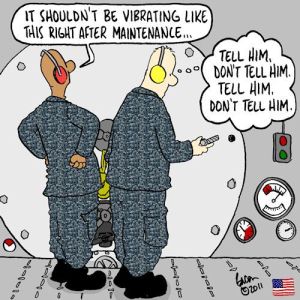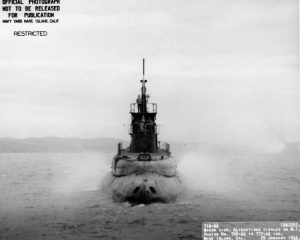USS Barb – SS-220
Posted by GP
This post is in response to a suggestion I received from Pat at e-Quips.
In the closing months of World War II, heavy losses and depleted fuel stocks kept many of Japan’s remaining combat aircraft grounded and warships in port, awaiting an anticipated amphibious invasion. Starting in July 1945, Allied battleships embarked on a series of naval bombardments of coastal cities in Japan in an effort to draw these forces out to battle — with little success.
However, a week before the battleships began lobbing their massive shells, a legendary U.S. submarine toting a rocket launcher began its own campaign of coastal terror that foretold the future of naval warfare — and also engaged in the only Allied ground-combat operation on Japanese home-island soil.
Submarines still made use of deck guns during World War II, most of them ranging between three and five inches in caliber. These were used to finish off unarmed merchant ships or sink smaller vessels that could evade torpedoes, but also were occasionally directed to bombard coastal targets, such as in early-war Japanese raids on the coasts of California and Australia.
Capt. Eugene Fluckey of the Gato-class submarine USS Barb volunteered his boat to try out the experimental rocket launcher in 1945.
At the time, the Navy was actually testing the weapon’s viability as an anti-kamikaze weapon, but Fluckey managed to cajole the R&D staff into releasing the Mark 51 in time for his patrol, making the Barb the only rocket-launching submarine of the Navy.
The Barb, which displaced 2,400 tons submerged, was one of the top-scoring Allied submarines of World War II. By the most conservative count, she sank 17 ships totaling 97,000 tons of shipping. Other tallies are considerably higher.
In January 1945, on his fourth patrol as commander of the Barb, Fluckey sneaked his boat into the shallow waters off of Namakwan Harbor off the coast of China and torpedoed six ships before hightailing away, an action that earned him the Medal of Honor.
The Barb set sail from her base in Midway on June 8 loaded with 100 rockets. She arrived off the Japanese home islands on June 20. At 2:30 a.m. on June 22, Barb surfaced off of the town of Shari in northeastern Hokkaido Island, unleashing a volley of 12 rockets into the slumbering community. She then sailed northward to the coast of Southern Sakhalin Island, then known as the Japanese prefecture of Karafuto. (All of Sakhalin is presently administered by Russia.)
Over the following month, the Barb expended 68 rockets on Shikuka. Shoritori and Kashiho, mostly firing late at night at near-maximum range.
When Japanese seaplanes began hunting the sub during the day, Fluckey retaliated with a volley of rockets aimed at the Shikuka military airfield. The Barb’s guns also destroyed more than three dozen civilian sampans, while her homing torpedoes took out local trawlers, tugboats and a few large merchant ships.
The Barb’s most famous exploit did not involve those weapons.
Observing trains passing along the Japanese coastline, Fluckey hatched a scheme to dispatch a landing party to blow up one of the trains by burying the Barb’s 55-pound scuttling charge — essentially a self-destruct device — under the tracks. Rather than using a timer, the explosives would be jury-rigged only to blow when the pressure of a passing train completed the circuit, a trick Fluckey likened to a childhood walnut-cracking prank.
A landing party of eight was selected on the basis of their unmarried status and membership in the Boy Scouts. Fluckey believed the scouts would have better pathfinding skills.
At midnight on July 23, the Barb slipped up to within a kilometer of the shore, and a landing party commanded by Lt. William Walke paddled quietly to the beach. While three men took up guard positions — they encountered a sleeping Japanese guard in a watchtower, whom they left unharmed — the other five buried the demolition charge and managed not blow themselves up jury-rigging the detonation circuit.
They were furiously rowing back to the Barb when a second train passed.
Fluckey described what happened next in his autobiography , “Thunder Below!”
“The engine’s boilers blew, wreckage flew two hundred feet in the air in a flash of flame and smoke, cars piled up and rolled off the track in a writhing, twisting mass of wreckage.”
All 61 train cars derailed, killing 150 passengers. The Barb’s crew added a train to the tally of enemy ships sunk on their battle flag. Her landing party had just performed what would be the only U.S. ground operation on the Japanese home islands during World War II.
The Barb’s raids on the Japanese coast — and even those performed by Allied battleships — were premised on the Japanese military’s inability, by 1945, to effectively defend the home-island coastlines, which included a lack of coastal-defense guns.
While the rockets the Barb employed appear to have been effective, it’s not clear that they were superior to having another deck gun. But within a decade of the Barb’s last mission, new rocket-based technologies in the form of guided cruise and ballistic missiles drastically reduced the relevance of big guns on warships or coastal defenses. The new weapons could be launched by a submerged submarine a long distance from the shore, safe from immediate retaliation.
The Barb’s month-long seaside rampage will remain a unique incident for some time to come.
Excerpts from: War Is Boring. com
CLICK ON IMAGES TO ENLARGE.
################################################################################################################
Military Humor –

for you submariners

Young submariners learn quickly to heed all signs!!
SIGN reads: “SECURE! Sanitation tanks under pressure!

################################################################################################################
Farewell Salutes –
Natasha R. Aposhian – AZ; US Air Force, 319th Logistics Readiness Squadron
Bernard Barry – Stanley, AUS; RA Navy, WWII
George Bjork – St. Paul, MN; US Navy, Aviation Ordnanceman 3rd Class
Stanley De Witt – USA; US Army, Korea, Sgt., Medical Detachment/57th FAB/7th Infantry Div., Bronze Star, KIA (Chosin Reservoir)
Pete Conley – USA; US Army, Korea, Cpl., Co. K/3/31/7th Infantry Division, KIA (Chosin Reservoir)
Thomas E. Griffith – USA; US Navy, WWII, radioman, USS Oklahoma, KIA (Pearl Harbor)
Ernestine “Tommy” King – Columbus, GA; Red Cross nurse. WWII
James Thomas Sr. – Montgomery, AL; US Navy, WWII & Korea, Lt. Commander
Julian C. Torres – TX; US Air Force, Airman 1st Class, 319th Security Forces Squadron
Jesse Vincent (100) – Leavenworth, WA; US Navy, WWII
################################################################################################################
About GP
Everett Smith served with the Headquarters Company, 187th Regiment, 11th A/B Division during WWII. This site is in tribute to my father, "Smitty." GP is a member of the 11th Airborne Association. Member # 4511 and extremely proud of that fact!Posted on June 11, 2020, in Uncategorized, WWII and tagged 1940's, Military, Military History, Navy, nostalgia, Pacific, Pacific War, submarines, USS Barb, veterans, WW2, WWII. Bookmark the permalink. 147 Comments.
Leave a reply to Jennie Cancel reply
This site uses Akismet to reduce spam. Learn how your comment data is processed.











Reblogged this on Ned Hamson's Second Line View of the News.
LikeLiked by 1 person
Thank you, Ned.
LikeLike
Reblogged this on faujibratsden.
LikeLiked by 2 people
Thank you.
LikeLiked by 1 person
Sir you have wonderful, unique experience to share..
LikeLiked by 1 person
I do not wish to mislead you, This is research on my part. I greatly appreciate your interest.
LikeLike
No sir it’s completely correct..a person with kind of your experience can’t mislead ever..
LikeLiked by 1 person
(blushing)
LikeLike
A really interesting story!
LikeLiked by 1 person
Thank you, Koji!
LikeLike
An amazing story — thanks GP.
LikeLiked by 1 person
Sure thing, Dennis.
LikeLike
These story’s of fantastic wartime deeds are phenomenal, yet fact to the older generations who lived through this era, today sadly, I think they may be perceived as fiction by the younger generation with no ties to that era.
LikeLiked by 1 person
They will never have heroes like these!! I believe you’re right, unfortunately.
LikeLiked by 1 person
What a great story! Good thing he selected Scouts. Did you you know that there is only one group of people who have all achieved the rank of Eagle Scout? The astronauts who landed on the moon. Navy, of course. I just love that.
LikeLiked by 1 person
Now there’s a fact I did not know.
LikeLiked by 1 person
🙂
LikeLiked by 1 person
I tried to comb all the comments and did not see how the famous ship ended. The Barb was conveyed to Italy, where she served until she was scrapped in 1972 according to the Wikipedia link. The submarine was renamed Enrico Tazzoli (S 511) by the Italian Navy, after Enrico Tazzoli. The submarine was eventually sold for scrap in 1972 for approximately $100,000. Admiral Fluckey is said to have remarked that had the crew known of this, they would have bought the sub and brought her back to the United States to serve as a museum ship. Would have been great to have preserved this historic ship.
LikeLiked by 1 person
You know me – I love all history preserved. I don’t blame Fluckey for being upset, she was a grand boat with an amazing history for herself and her crew.
LikeLiked by 1 person
Good post and I enjoy reading all your comments too, so full of information that I know little about.
LikeLiked by 1 person
I am very lucky that my readers feel free to tell their stories here and contribute additional facts to a post. It all helps to make this history and blog their own.
LikeLiked by 1 person
Thank you.
LikeLike
Pingback: USS Barb – SS-220 – faujibratsden